| New York
Architecture Images- Recent Franklin D. Roosevelt Monument |
|
| Please note- I do not own the copyright for the images on this page. | |
|
architect |
Louis Kahn and Mitchell/Giurgola |
|
location |
Roosevelt Island |
|
date |
2012 |
|
style |
Brutalist |
|
type |
Monument |
|
construction |
granite memorial and overarching double row of linden trees narrowing to a single stone room open to sky and sea with a lawn for 7,000 spectators to view performances on a removable stage. There is also a sledding hill and a skate pond. |
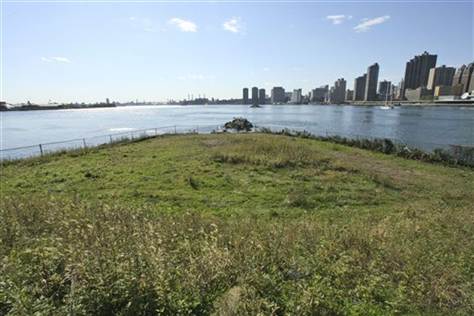  |
|
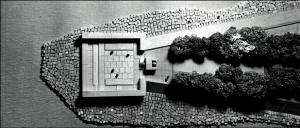 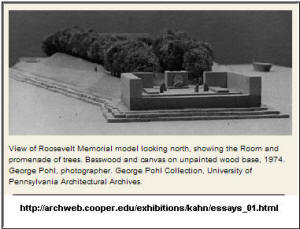 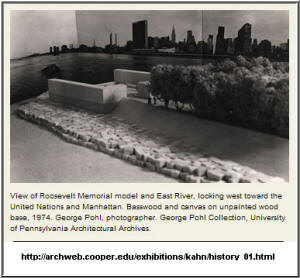 |
|
| A model and a sketch by Kahn of the proposed memorial on Roosevelt Island. Open to the sea and sky, the granite-walled room at the island's tip would have Roosevelt's "Four Freedoms" speech inscribed on one wall. | |
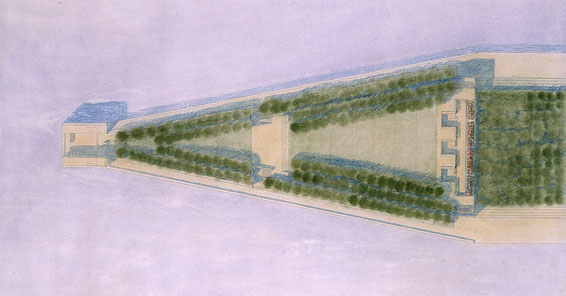 |
|
| Construction | |
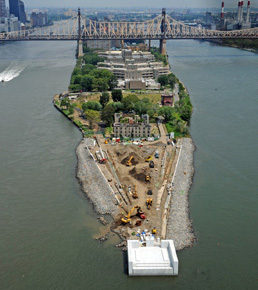 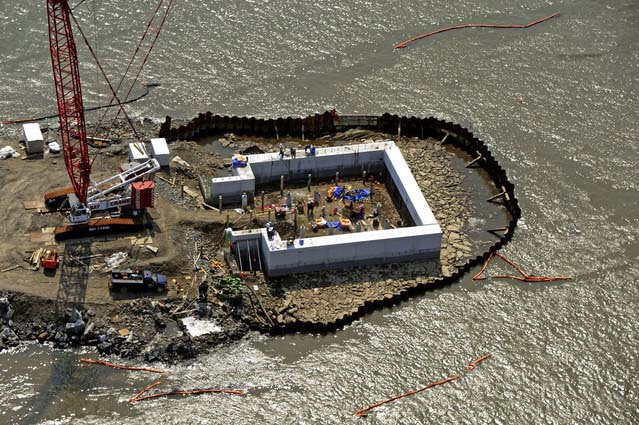 |
|
| Today | |
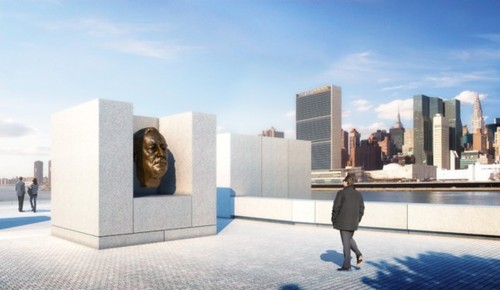 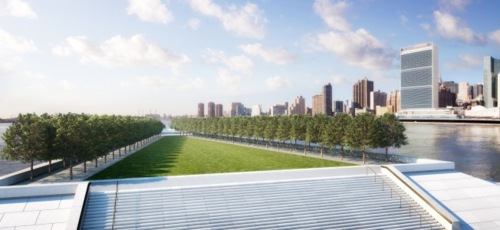 |
|
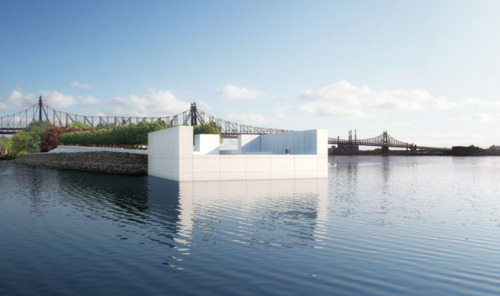 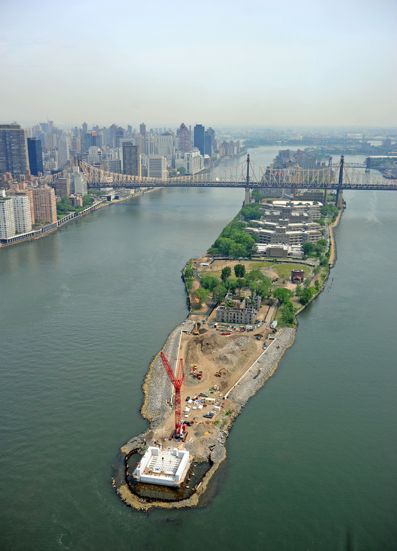 |
|
| The old Smallpox Hospital | |
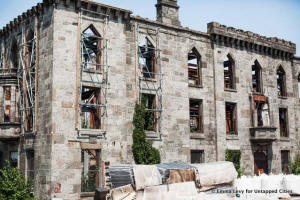 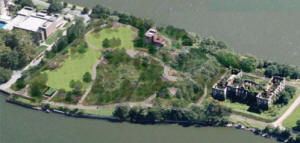 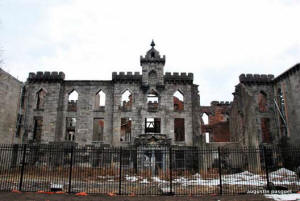 |
|
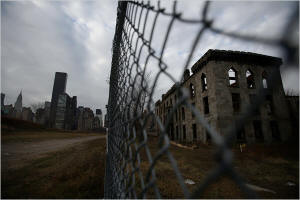 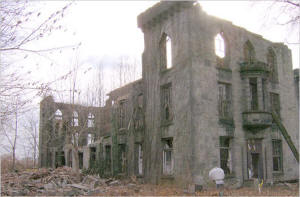 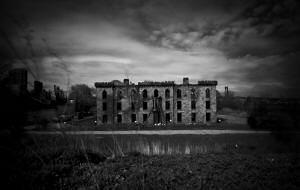 |
|
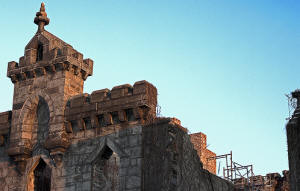 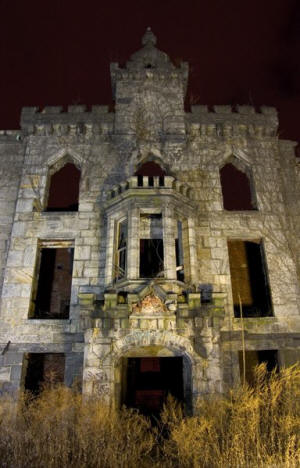 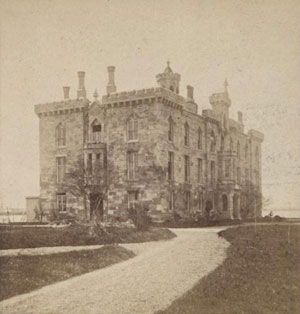 |
|
| Above- Shoring Up a Landmark Ruin on Roosevelt
Island By David W. Dunlap, April 14, 2009 When we last left the haunting Gothic ruin of the old Smallpox Hospital on Roosevelt Island, it was more ruined than ever. While the abandoned, roofless, 153-year-old building was awaiting structural stabilization in late 2007, a large section of its north facade collapsed spontaneously, apparently the victim of moisture-filled interior walls expanding and contracting through endless cycles of freezing and thawing. Preservationists were especially dismayed, having long urged that some measures be taken to protect the structure, which was designed by James Renwick Jr., the architect of St. Patrick’s Cathedral. “They should bring in the cavalry and fix this important landmark,” Peg Breen, the president of the New York Landmarks Conservancy, said at the time. 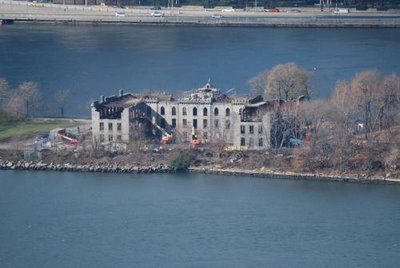 The cavalry — in the form of engineers, architects, masons and ironworkers — has arrived. The freestanding granite, brick and rubblestone walls have been repointed. Even more noticeably, the first two of five steel framework towers have been erected within the walls. These towers will be connected to the old walls to help keep the remaining structure upright while permanent plans are drawn up for its reuse. The happiest discovery of the project was that the necessary bracing could be constructed entirely inside the picturesque walls, which are illuminated at night. There turned out to be no need for exterior scaffolding. Last week, City Room was given a tour of the increasingly sturdy ruins by Stephen H. Shane, the president and chief executive of the Roosevelt Island Operating Corporation, the state agency that oversees the island; Andy Stone, director of the New York City program of the Trust for Public Land, which is overseeing the $4.5 million stabilization project as part of the larger Southpoint Park plan; and E. Timothy Marshall, the president of ETM Associates, a New York City Parks Department veteran who is a planning consultant to the trust. “I think they’ve done a wonderful job,” Ms. Breen said on Monday, “and we’re just thrilled.” Copyright 2009 The New York Times Company Source- http://cityroom.blogs.nytimes.com/2009/04/14/shoring-up-a-landmark-ruin-on-roosevelt-island/ |
|
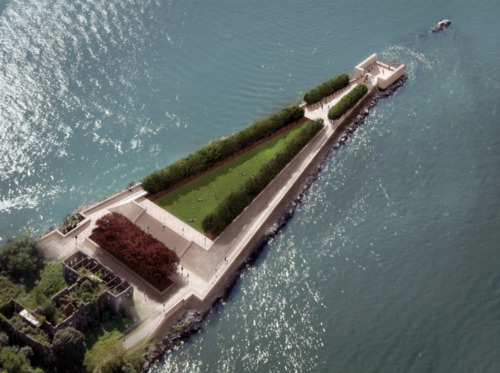 |
|
|
notes |
Kahn's Franklin D. Roosevelt Monument
An Elegy for a Memorial, and for the Man Who Designed It By JULIE V. IOVINE, January 9, 2005 SUE ANN KAHN vividly remembers hearing the news of Franklin D. Roosevelt's death in 1945, while eating dinner at her grandmother's house. Her father, the architect Louis I. Kahn, had turned on the radio in the dining room, an unprecedented breach of decorum. The whole family stood up to observe a moment of silence. "I didn't understand what it was all about," said Ms. Kahn, only a child at the time. "But I knew something momentous had just happened." Years later, in 1972, Louis Kahn, widely recognized as one of America's most original modern architects, set to work creating a monument dedicated to Roosevelt for New York City. Designed to adorn the southernmost tip of Roosevelt Island, the memorial - a double row of trees narrowing to a single stone room open to sky and sea - framed views of the harbor and skyline with the simple but stirring monumentality of a Greek temple. Although Kahn completed the design, and a local architect prepared the documents needed for construction, the memorial was never built, the victim of a city fiscal crisis. The Franklin D. Roosevelt Monument turned out to be one of the last projects completed by Kahn, who died while traveling in 1974. His body was found unattended in the men's room at Pennsylvania Station. A notebook with sketches and jottings about the memorial was found with his belongings. Now the Roosevelt Island Operating Corporation, the state-appointed organization that runs the island, has commissioned a new design by a New York landscape designer for the 14-acre site, known as Southpoint Park. Taking into account feedback from residents and visitors, the design would substitute the granite memorial and overarching linden trees of Kahn's plan with a lawn for 7,000 spectators to view performances on a removable stage. There would also be a sledding hill and a skate pond. Devotees of Roosevelt and of Kahn are hoping that it is not too late to reconsider Kahn's 2.8-acre memorial as part of the 14-acre site. With renewed interest in the art of memorial-making (because of plans for ground zero) and in the work of Kahn (because of a film made last year by his son, Nathaniel), the time is finally ripe, they say, to realize Kahn's plan. Peter Reed, a curator at the Museum of Modern Art who worked on the 1992 Kahn show at the museum, described the memorial project as "a great opportunity for New York City to get a building by Kahn." "It addresses in architecture," he said, "the same spirit of optimism that Roosevelt expressed in his leadership." 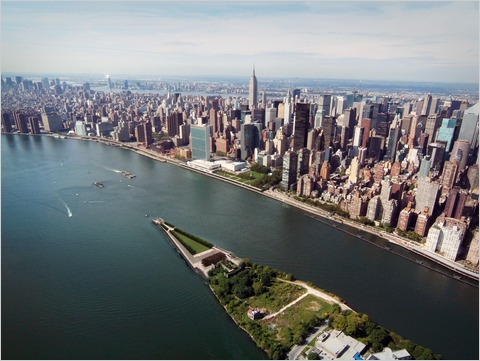 Beginning Monday, a show at Cooper Union will allow a larger audience to see for the first time much of the project's original documentation, including Kahn's drawings, the first presentation model, the sketchbook found at his death and construction documents made on waxed linen by his associate architects, Mitchell/Giurgola of New York. At a symposium on Jan. 25, historians and architects will consider the project and changing ideas of monumentality. "Of all the unbuilt projects, this is the one that really could be done, and now, more than ever, should be done," said Nathaniel Kahn, whose film "My Architect," tracking the indelible imprint left by his brilliant but emotionally opaque father on family, colleagues and the world, was nominated for an Academy Award last year. "Surely that incredible site cannot be given over to just another public space. It has to be something really special. New York City needs a great monument to Roosevelt." But those opposed to the memorial say supporters waited too long. "Kahn's memorial was played out in a different time, a different era, a different world," said Herbert Berman, president of the Roosevelt Island Operating Corporation. "It was right for 30 years ago, not for now." Today, he said, those who live on Roosevelt Island are interested in less formal uses for the land. In a survey, residents complained that the memorial would cost too much, that the trees in the Kahn proposal would block their front-row view of Fourth of July fireworks and that the granite structure was too severe. Further interviews revealed that residents enjoyed the disrepair that characterized the site, especially the ruins of a smallpox hospital built in the 1850's when the island was used to quarantine the sick. But locals said they also wanted the park to be a place for contemplation, not just for sporty recreation. More than a fifth of the island's 9,500 residents are handicapped (patients, outpatients and former patients from the Coler-Goldwater Specialty Hospital). There are many playing fields for children elsewhere on the island. Last April, the operating corporation invited the Trust for Public Land, a national nonprofit organization that helps communities protect and conserve land by developing parks and recreational activities, to come up with new proposals for attracting people to the park and to the island. In November the trust presented the operating corporation with "Wild Gardens/Green Rooms," a picturesque park designed by Mark K. Morrison, a local landscape designer who is currently working on security fencing for the United Nations, as well as on numerous Manhattan playgrounds. The design includes a cafe in the ruins of the smallpox hospital and an earth mound providing enough contour for sledding in winter. The removable stage at the edge of a large lawn would be located at the southernmost tip, where Kahn put his granite room open to the sea. The 14-acre "Wild Gardens" would cost approximately $34 million to complete, with a first phase planned at $10 million needed to stabilize the collapsing hospital ruins and clear pathways on the west side to the now inaccessible point. That's $4 million more than Kahn's 2.8-acre memorial design would cost, according to a revised budget prepared in 2003 for the Franklin and Eleanor Roosevelt Institute by the Plaza Construction Corporation. In February the Trust for Public land will present "Wild Gardens" to the board of directors at the Roosevelt Island Operating Corporation for final approval; the board will then seek the necessary financing from public and private sources. "Louis Kahn would have done it differently if he were alive today," said Charles McKinney, the consultant in charge of the Roosevelt Island park proposal for the Trust for Public Land. "He was well known for his concerns about creating communal spaces, and he would have understood the importance of this community's concerns, and he would have responded." "Hundreds of thousands of people see the island from their apartment windows or their cars and are intrigued," he continued. "Some take trams out to see it, but when they get there, nothing happens. There needs to be something for them to look at and to do." Certainly, the mandate was different 30 years ago. Kahn's commission was part of an ambitious island redevelopment plan begun by the New York State Urban Development Corporation. The island, then known as Welfare Island, It had been not only a quarantine spot, but also a prison, a lunatic asylum and a quarry. The plan, announced by Mayor John V. Lindsay in September 1973, was to turn the island into a varied-income urban utopia (along the lines of the planned community in Reston, Va.), with the Roosevelt memorial, the only one in New York City, as its centerpiece and chief attraction. Kahn was inspired by Roosevelt's famous "Four Freedoms" speech (about freedom from want, freedom to worship, freedom from fear and freedom of speech) delivered to Congress on Jan. 6, 1941, at one of the darkest hours of the war, after France had fallen, but before Pearl Harbor. As he developed his design, Kahn, an émigré from Estonia, was keenly aware of the United Nations' presence right across the river. "Roosevelt said he didn't want any memorial, only a plaque in front of the National Archives" in Washington, said William vanden Heuvel, a chairman of the Franklin and Eleanor Roosevelt Institute. "But the 'Four Freedoms' speech was very much part of how he thought of the world he wanted to see." With the announcement of the plan, the island was renamed Roosevelt Island. Kahn worked on the design for about a year, said Harriet Pattison, a landscape designer (and Nathaniel Kahn's mother) who worked with Louis Kahn on the project. All Kahn's revisions, she added, were aimed at making the design simpler and more timeless. The site was to be on an elevated platform of land - arduous earth-moving work was done in the mid-1990's in anticipation of the Kahn plan's being realized - so that a grand staircase could be positioned as a threshold. (At that time, Mitchell/Guirgola also added ramps for handicap access.) From the top of the stairs, a wide lawn would line both sides with rows of linden trees, narrowed to the point. There, looking out to sea, a square room would be built of monumental granite blocks standing side by side, with a one-inch gap allowing sun to filter through. Two parallel walls were to stand 12 feet high, but there would be no roof. On one wall, the "Four Freedoms" speech would be inscribed. There was also talk of a statue and a bust of Roosevelt. On the side facing south toward the harbor, the room was to be left open, with a low wall for sitting. At high tide, water would rise up stone banks, and the room would appear from a distance to be almost floating. "Kahn made monuments that address nature like the ancients did, with a sense of the infinite," said Michael Lewis, a professor of art at Williams College who has written the introduction for the Cooper Union exhibition catalog, noting that monumentality was a subject always on this architect's mind. (Kahn designed several memorials, including the Memorial to Six Million Jewish Martyrs in Battery Park.) None were built. "But this was the most important of all his monuments, summing up 50 years of his thinking about it," Mr. Lewis said. "It was the ripest of all his monuments and it would be a coup for New York City to have it." In addition to the drawings from the Kahn archive in Philadelphia, which are rarely shown in public, the exhibition at Cooper Union will include a digital projection showing Kahn's memorial as it would look on Roosevelt Island, against a backdrop of New York City as it would appear in 2007, complete with the new Queens West housing development just across the river. Mr. Berman at the Roosevelt Island Operating Corporation said that the next step was to try to secure state financing to go forward with the "Wild Gardens" proposal, while supporters of Kahn's Roosevelt Memorial said that theyd hope the exhibition would attract enough attention to revive serious interest in building Kahn's plan. Kahn would probably have been philosophical about the new twist of fate for his last monument design. At a lecture last year about his unbuilt works, Ms. Pattison read a statement by Kahn. "That which is not built is not really lost," he wrote. "Once its value is established, its demand for presence is undeniable. It is merely waiting for the right circumstances." Copyright 2005 The New York Times Company 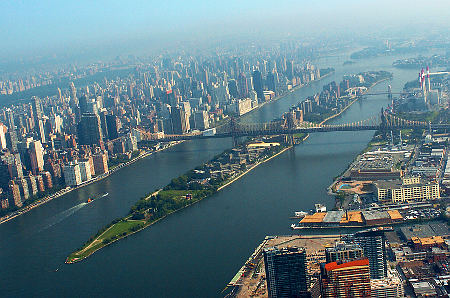 Plan revived for FDR memorial in NYC By RICHARD PYLE, Associated Press Writer Sun Nov 25 NEW YORK - George Washington, a Virginian, has his statue on Wall Street, Ohio-born Ulysses S. Grant has his tomb overlooking the Hudson. But for reasons nobody can easily explain, New York native son Franklin Delano Roosevelt has no official memorial in this city. Not that the name is forgotten: There is FDR Drive in Manhattan, Roosevelt Avenue in Queens and Roosevelt Island in the middle of the East River. There is also a memorial to FDR's wife, Eleanor. Now, after lying dormant for three decades, plans are being revived to give Roosevelt his due as the 32nd president and author of the New Deal, who led the United States through most of the Great Depression and World War II. It would come in the form of a stone edifice at the southern tip of Roosevelt Island, a two-mile-long sliver of land renamed for FDR in 1973. For more than a century before that it was Welfare Island, with hospitals, a poorhouse, a penitentiary and a lunatic asylum. In 1841, Charles Dickens visited the asylum; in 1888, muckraking reporter Nellie Bly posed as a patient for 10 days to expose its deplorable conditions. Roosevelt Island today is a high-rise village of 10,000 people including United Nations diplomats and staff from the cluster of hospitals on Manhattan's East Side. The only remnant of the past is the skeletal remains of the Smallpox Hospital, which is known as the Renwick Ruin and is eerily illuminated at night with funds from an anonymous donor. The name change in 1973 was in anticipation of an FDR memorial being built. Famed architect Louis I. Kahn drafted a design, but a city fiscal crisis delayed the project. When Kahn died of a heart attack in a men's room in Penn Station a year later, drawings of the memorial in his pocket helped police identify the body. Money problems, political inertia and faded public interest kept Kahn's plan on the shelf until it was recently dusted off as the centerpiece of a new effort to honor the former president. The design features a sloping lawn and V-shaped promenades leading to an open space with granite walls, framing views to the south and west of the river and Manhattan towers, including the U.N. complex. It would border a 10-acre park, being developed separately. "It's now or never," says City Councilwoman Jessica Lappin, the FDR project's leading advocate, noting that once construction begins on the park next year, plans for the memorial could be imperiled. One big problem is the financing: the nonprofit Franklin and Eleanor Roosevelt Institute has so far raised just $6 million, a fraction of the memorial's $40 million projected cost. Mayor Michael Bloomberg and Gov. Eliot Spitzer have declared support for the project, as have members of Congress and other politicians. But no government funds have been forthcoming. Gina Pollara, who manages the institute's fundraising effort, said she expected an infusion of more money soon. "We hope this will include contributions from the city and the state, as they promised when this project began 35 years ago," she said. The FDR memorial would be built to Kahn's design or not at all, its advocates say. "We are in this amazing position to build to a design by the 'architect's architect,' a master of the 20th century," Pollara said. In an interview at the deserted, windblown memorial site, Lappin called Kahn's concept "a timeless, elegant design" sure to draw visitors from around the world. "Having 14 undeveloped acres in the middle of the river is a one-time chance to do something right, that people will enjoy forever," she said. "If the FDR memorial doesn't happen, there's no other plan for those three acres. People could put up luxury condos. It's up for grabs, and that makes me nervous." Island residents don't appear to be jumping with enthusiasm for the project. Comments on a community Web site tilted toward the negative, with critics saying it was too isolated; did not reflect FDR's legacy of social reform; would ruin a goose nesting ground; or was too expensive. Dick Lutz, managing editor of The Main Street WIRE, the island's community newspaper, said that while some people support the plan as a way to block real estate developers, resistance stems from residents' desire for more green space, and a view that the project is "more a memorial to its architect than to FDR." In any case, he said, funding is the key question. "Without it, the project could linger for another decade." ---------------------------- From the Roosevelt Island NIMBY rag: Memorial to lous kahn or fdr at southpoint park? The images above are from the proposed Louis Kahn Memorial purported to be for President Franklin Roosevelt that some hope to be installed at Southpoint Park on Roosevelt Island, (Top image is from Architectural Record, bottom from NY Times). The New York Sun is reporting today that: A plan to build a memorial to President Franklin Roosevelt on Roosevelt Island is getting a boost from city leaders, who are meeting today to underscore their support for the initiative. The movement for the memorial, which was designed by architect Louis Kahn almost 35 years ago, needs to raise $40 million by the end of the year; as of July 20, it had collected $5.1 million. The city leaders set to attend the event include Democratic Congresswoman Carolyn Maloney; City Council Speaker Christine Quinn; City Councilwoman Jessica Lappin; New York State Assembly member Micah Kellner, and the president of Manhattan, Scott Stringer. As I have stated before, my impression is that for many proponents of the Memorial, their support is based more upon the desire for a Louis Kahn project in NYC than to honor President Franklin D. Roosevelt, particularly since there is an existing FDR national memorial near the National Mall in Washington DC and Roosevelt Island as well the FDR Drive are named after the late President. Those in support of this proposal should know that there are many residents of Roosevelt Island who do not want this massive granite structure with rows of trees obstructing the beautiful waterfront views from Southpoint Park and further impeding access to the East River. This NY Sun article had the following statement indicating opposition to the Louis Kahn memorial by Roosevelt Island residents: The president and CEO of the Roosevelt Island Residents Association, Matthew Katz, said he is concerned that the memorial will cut off views to the east and west. A survey of residents found that most want "the greenest thing possible" in that space, he said. "The Roosevelts were gods in my house, growing up," Mr. Katz said. "Whether this is the appropriate memorial is another question." The association's secretary, Sherie Helstien, said that by resisting Kahn's memorial design, residents are trying to "save the last big community park" in the city. "I think a lot of us are just hoping they don't get the money," she said. "We don't want that thing here." I agree. We do not want any green space nor access to the water from Southpoint's Park removed because of this proposed memorial. More background on this issue from this NY Times 2005 article: the Roosevelt Island Operating Corporation, the state-appointed organization that runs the island, has commissioned a new design by a New York landscape designer for the 14-acre site, known as Southpoint Park. Taking into account feedback from residents and visitors, the design would substitute the granite memorial and overarching linden trees of Kahn's plan with a lawn for 7,000 spectators to view performances on a removable stage. There would also be a sledding hill and a skate pond. ..."Kahn's memorial was played out in a different time, a different era, a different world," said Herbert Berman, president of the Roosevelt Island Operating Corporation. "It was right for 30 years ago, not for now." Today, he said, those who live on Roosevelt Island are interested in less formal uses for the land. ...Last April, the operating corporation invited the Trust for Public Land, a national nonprofit organization that helps communities protect and conserve land by developing parks and recreational activities, to come up with new proposals for attracting people to the park and to the island. In November the trust presented the operating corporation with "Wild Gardens/Green Rooms," a picturesque park designed by Mark K. Morrison, a local landscape designer who is currently working on security fencing for the United Nations, as well as on numerous Manhattan playgrounds. The design includes a cafe in the ruins of the smallpox hospital and an earth mound providing enough contour for sledding in winter. The removable stage at the edge of a large lawn would be located at the southernmost tip, where Kahn put his granite room open to the sea. ..."Louis Kahn would have done it differently if he were alive today," said Charles McKinney, the consultant in charge of the Roosevelt Island park proposal for the Trust for Public Land. "He was well known for his concerns about creating communal spaces, and he would have understood the importance of this community's concerns, and he would have responded." Here is a link to the Southpoint Park Conceptual Plans discussed above including the Wild Gardens/Green Rooms concept approved by most residents as well as the Visionary Landscape concept that includes the Kahn Memorial, assuming funding can be obtained. If the proposed Louis Kahn memorial is built, Roosevelt Island loses opportunities for special events that produce views like this from Thom Sokoloski's The Encampment as well as normal everyday experiences of walking down to beautiful green parkland and listening to the sounds of the East River. Or maybe even the possibility of importing a sand beach to Southoint Park similar to the one in Long Island City at the NY Water Taxi Beach. .. ---------------------------- A Roosevelt for Roosevelt Island Published: November 5, 2007 Slicing into the East River, flanked by Queens and Manhattan, Roosevelt Island should be a destination. Plenty of people take the tram from Manhattan’s East Side, but unless they live, work or go to school on the island, there is little else to do, except take the tram back. Four decades ago, state planners envisioned something very different. Where there is now wild growth and a relic of a smallpox hospital on the southern end, they began work on a memorial to President Franklin Delano Roosevelt. Fittingly, what was then called Welfare Island — reflecting its use as a site for rehabilitation hospitals — was renamed for Roosevelt. The eminent architect Louis Kahn was commissioned to design the memorial, and his concept was simple and elegant. Drawing inspiration from Roosevelt’s defense of the Four Freedoms — of speech and religion, and from want and fear — he designed an open “room and a garden” at the bottom of the island. Trees on either side form a “V” defining a green space, and leading to a two-walled stone room at the water’s edge that frames the United Nations and the rest of the skyline. Unfortunately, the project never got much further than that. The near-bankruptcy of New York in 1975 intervened, and the memorial was given up, until now. Jessica Lappin, who represents the Upper East Side and Roosevelt Island on the City Council, wants to give it another go. The issue, again, is money. The state, which owns the island and expects its budget to be short more than $4 billion next year, cannot commit large sums. So far, an attempt by the nonprofit Franklin and Eleanor Roosevelt Institute to pay for the memorial has raised only about $6 million of an estimated $40 million needed. And if the memorial is to be built, work will need to begin in the next few months, at the same time building starts on an adjacent 10-acre park. There’s a magic to the project. That the task is daunting makes it worthy of the man it honors, who guided the nation through the Depression, the New Deal and a world war. As for Mr. Kahn, he died in 1974, as he passed alone through New York’s Penn Station. In his briefcase were renderings of the memorial, his last completed plan. |
|
|
|
|
|
Roosevelt Island: Is this the start of a new look?
BY JASON SHEFTELL DAILY NEWS REAL ESTATE CORRESPONDENT, January 24th 2008 The refurbished cupola and residential wings of the Octagon Everyone has a story about Roosevelt Island. The first time you set foot on the 2-mile long, 800-foot-wide swath of land can be jarring because of the oddly shaped buildings, large hospitals on both ends of the island and a dark and dingy Main St. The island has long been known for its history as a place where physically disabled and psychiatric patients were treated. With the luxury of more parkland than apartment buildings, the island should be an idyllic Manhattan location with magnificent skyline views of three boroughs. For residents, however, it can also mean living with complex community politics. The island is split into Northtown and Southtown with a lighthouse park on the north end of the island and communal gardens that attract organic food growers in the summer. A Little League field overlooks the East Channel of the East River. There are tennis courts on both ends of the island, and a park where the ruins of a 19th-century hospital are surrounded by wild vegetation. You would think residents would be smiling. Mostly, they are. But this is New York City. Opinions are currency, and the people on Roosevelt Island have them. "For the most part we have lived off the good graces of New York State for the better part of the past 30 years," says Judith Berdy, president of the island's Historical Society. "There are some who think we have suffered. Politics is a disease out here," adds Berdy, who has lived in three residences on the island in that time. The management: Stephen Shane runs the Roosevelt Island Operating Committee (RIOC), the group designated by the state to manage the island's tram system, landscaping, public safety and Main St. retail component. He was appointed in 2007 by Gov. Spitzer. An ex-real-estate attorney and special assistant to commissioner of the New York State Department of Housing, Shane has worked with developers to bring upscale residential buildings to the island while trying to maintain affordable housing at a time when some residents want to privatize public housing and take the real estate money and run. "You cannot do everything at once," says Shane, who according to some has made more progress in six months than several of his predecessors did in several years. "People may have got spoiled out here. Sometimes I think the residents forget what it is to live in Manhattan, the Bronx or Queens." Nevertheless, renting retail space on Main St. is still a problem that needs fixing. Because of legislation enacted to prevent state-operated groups from committing fraud, it takes nine months to a year to go through the approval process to rent an 800-square-foot store on Roosevelt Island. "I've tried several things to exempt us from this legislation," says Shane. "I'm still trying. "This is one of the most unique and special places in the world, but it's also the most complex." Renting or buying an apartment on Main St. falls under the Mitchell Lama affordable housing program and can take to two to five years. One resident, for example, waited 13 years for a $26,000 studio. Northtown: On the north side of the island, the Octagon building might be New York City's finest example of historical refurbishment. The cupola of the old mental asylum was renovated and developed by Becker & Becker, architects with offices in Fairfield, Conn., and Union Square, who have created more than 400 high-end and 100 middle-income units. Some residents sued the developer, trying to reclaim parkland, but lost, and so the Octagon becomes part of the island's future. "You shouldn't restore something if you don't have a good history of having done it well before," says Bruce Becker, who says that plans for a water taxi to and from Manhattan are in place. "Developing 5 acres on the coast of Manhattan with an historical conversion became a personal obsession for me. I wanted to do it right." The Octagon looks like a country club. The The LEED (leadership in energy and environmental design)-certified building has a private pool, day care center, art gallery, computer center and a deli in the lobby. Nearby parkland has public tennis courts, barbecues and seating areas along the promenade. Rents range from $2,000 for a 510-square-foot studio to $4,500 for a three-bedroom with water views. Manhattan Park, a 19-year-old, four-building complex on Main St. in Northtown, has one-bedrooms renting for $2,095 and two-bedrooms for $2,795. Three- and four-bedrooms are also available, starting at $3,395. Southtown: After 30 years, the area around the tram and subway station has been developed into six residential towers. The well-landscaped area, developed by Related and the Hudson Companies, Inc., has already brought a Starbucks, Duane Reade, a Japanese restaurant and a pizza parlor to the island. Riverwalk Court condo, the fifth building in the development, has a 713-square-foot one-bedroom/ one-bath starting at $595,000, with a monthly maintenance of $598 and annual taxes of $58. Two-bedroom/two-baths go for $935,000. These prices are 30% less than in midtown. "We're committed to nine buildings in this section of the island," says Bruce Beal Jr., executive vice president of Related Companies. "The buildings, the retail and landscaping add value to the area's tremendous appeal." Living there: Roosevelt Island's 14,000 residents are a mix of different races, income levels and nationalities, including representation by workers at the United Nations. Walking the island's periphery, I see joggers, walkers and people enjoying the Manhattan skyline. Seagulls swoop to and from the shore. Because of the specialist hospitals in the area, you'll see many motorized wheelchairs. "This is a social experiment gone right," says Matthew Katz, president of the Roosevelt Island Residential Association, the same group conducting elections to propose local board nominations to RIOC President Shane. "It's an urban ecological center with a small- town feel minutes from midtown. There is no other place in the world like it." P.S./I.S.287 is in the middle of the island between Southtown and Northtown on Main St. Every parent I ran into said something positive about the school. There are no garbage trucks on the island. Each Roosevelt Island residential structure works with an AVAC garbage disposable system that transports garbage via underground compression tubes to a centralized trash compacting center. Getting there: Take the Roosevelt Island tram at 59th St. and Second Ave. It's a marvelous ride with views of Manhattan skyscrapers and the 59th St. bridge. The F Train stops on the island, but residents complain about overcrowding even during non-rush hour hours. The Red Bus, which costs $1, on Main St. and runs about every 10 minutes. To drive, the Welfare Island bridge connects with Queens. The Q102 bus goes to Astoria, making stops at Roosevelt Island. The history: After the Dutch bought the land from two chiefs of the Canarsie Tribe in 1637, it passed through an English family to a son-in-law named Robert Blackwell. In the early 19th century, the city purchased Blackwell Island for $16,000. It became a prison for malcontents, murderers and juveniles. A "lunatic asylum" with an octagonal cupola was built on the north side of the island. In 1921, Blackwell Island was renamed Welfare Island. The prison closed in 1935 and moved to Rikers Island. The hospitals and research centers remained. Until the mid-1960s, the island was seen as primarily as a medical facility before contemplating the development of the barren land between the hospitals. In 1969, the city leased the land to the state, which invested $180 million in infrastructure for plumbing and electricity, preparing the island for residents. Architects Philip Johnson and John Burgee created a mixed-use utopian plan with 5,000 units of affordable to upper-income housing for an eventual population of 15,000. Finally, in 1973, the island was named Roosevelt Island, in honor President Franklin and Eleanor Roosevelt with new residential buildings lining Main St. Eastwood, with more than 1,000 units, reserves 25% of the apartments for the elderly or disabled. The island, finally, began to take shape as a residential neighborhood. My verdict It's clear Roosevelt Island residents don't know how good they have it. Yes, they've worked hard to build a small-town feel and they deserve to maintain it, but they might want to try working with each other as opposed to against each other. This is a fantastic and peaceful place to live. Without the complaints, lawsuits, constant jockeying for political representation and state problems with the retail, the island has a chance to become an outdoor wonderland with a front-view view to the finest skyline in the world. What could look like Catalina Island off the coast of Los Angles or the South Street Seaport instead resembles abandoned retail stretches of the South Bronx circa 1976. It's depressing, and the state needs to take a look. As for the politics, I just hope the personal-interest groups don't turn a beautiful neighborhood into a hard place to live, or worse place to visit. Copyright 2008 THe New York Daily News ------------------------ Whoosh! The Trash Can as a Pneumatic Tube By EMILY S. RUEB Underneath the 40-block strip of land between Queens and Manhattan known as Roosevelt Island is a complex system of pneumatic tubes that connects the island’s 12,000 or so residents. But it’s not mail that’s hurtling through them at at 30 miles an hour. It’s garbage. Vacuum cleaners, Christmas trees and last night’s unfinished dinner have all passed through the intestines of the Automated Vacuum Assisted Collections facility, a pneumatic trash system built in 1975 that seems forever ahead of its time. An exhibit titled “FAST TRASH: Roosevelt Island‘s Pneumatic Tubes and the Future of Cities,” examines this Jetsons-like system and how it can be used as a model for hauling away unwanted items in other cities. Curated by the architect Juliette Spertus and the design firm Project Projects, the month-long exhibit opens on April 22, Earth Day, at the Rivaa Gallery on the island. “The point is to get the conversation started,” Ms. Spertus said. By showing how other cities like Barcelona, Macao and Stockholm are retrofitting or using the technology, she hopes that the range of projects displayed will provoke people to think differently about urban planning. A panel discussion at the New York University Wagner Graduate School of Public Service called “Comparative Garbage Collection Strategy and Urban Planning” will follow on May 6. The “Fast Trash” show will dissect the pneumatic transport system using explanatory diagrams and video interviews with the engineers who maintain the system, and offer a little bit of whimsy. A selection of drawings by students from the Child School explore what garbage collection might look like in a future without roads. The show also celebrates the 40th anniversary of the master plan that the architects John Burgee and Philip Johnson developed for what was then called Welfare Island. Judy Berdy, the president of the Roosevelt Island Historical Society and a 32-year resident, said she hoped the exhibit would shine a light on the island she called “a perfect Utopian village.” She praised the clean and efficient trash system, but said it was in perpetual jeopardy. “Every year the sanitation department threatens to cut it from the budget, and every year our councilman saves it,” she said. The staff of eight full-time engineers perform regular repairs and maintenance on the system, monitoring the vacuum seals and gauges, which are often on the fritz. They have halted the engines for residents who panicked about missing false teeth, wedding rings and pocket books that have been sucked under the city’s streets. And even let them sift through a 12-ton pile of refuse. Ms. Spertus compared the trash tubes with another better-known and relatively beloved piece of infrastructure on the island, the tramway that connects it to Manhattan. Because the trash system is invisible to residents, she said, it suffers from a lack of respect. “What they like about it is, they don’t have to think about it,” said Ms. Spertus. “It’s not something you can ride on.” http://cityroom.blogs.nytimes.com/2010/04/09/whoosh-the-trash-can-as-a-pneumatic-tube/#more-156927 |
| A Groundbreaking 36 Years in the Making By SAM ROBERTS On March 17, 1974, the architect Louis I. Kahn died of a heart attack as he was walking through Pennsylvania Station in Manhattan. He was 73. In his briefcase were the final drawings, which he had just completed, for the Franklin Delano Roosevelt Memorial to be built on the southern tip of Roosevelt Island. A few weeks later, state officials approved Mr. Kahn’s design. They said construction would begin before the end of the year. Even if Mr. Kahn had not died, he almost certainly would never have lived long enough to see any evidence of his design bearing fruit. Ground was finally broken late last month for the triangular four-and-a-half acre Franklin D. Roosevelt Four Freedoms Park across the East River from the United Nations. There was no ceremony or announcement. A formal groundbreaking will be this summer to celebrate the start of the final phase of Roosevelt Island’s planned development. The project was conceived 40 years ago when the Franklin and Eleanor Roosevelt Institute (then known as the Four Freedoms Foundation) initiated the planning of a memorial in New York. In 1973, Roosevelt Island was officially renamed (from Welfare Island) and plans for a memorial were disclosed. But the project encountered what William J. vanden Heuvel, who founded the Roosevelt Institute in Hyde Park, N.Y., to preserve the legacy of Franklin and Eleanor Roosevelt and has been instrumental in raising money for the memorial, called “a perfect storm” of obstacles. New York City became mired in a fiscal crisis, and Gov. Nelson A. Rockefeller, an advocate for the project, was named vice president and left town. The memorial is expected to cost about $50 million. Nearly $35 million has been raised so far, including $10 million in government funds and a $10 million gift from the Alphawood Foundation of Chicago. Visitors to the memorial will enter past a stand of copper beech trees. They will ascend a monumental stair to allees of 150 linden trees flanking a sloped lawn and culminating in a granite-lined open-air plaza called the “room,” which will house a bust of the former president and will be engraved with the Four Freedoms (speech and religion and an absence of want and fear) he proclaimed in a 1941 speech. People who donate a tree will have their names engraved on a granite parapet with relevant Roosevelt references. “If we’re lucky in raising these funds, we’ll be finished in a little over two years,” Mr. vanden Heuvel said. “It’s an opportunity for people to have their names attached to what is going to be a world-class monument the moment it’s finished.” After all the delays, he said it was particularly appropriate that construction had begun as the nation emerges from the biggest financial crisis since the Depression and under a president whose oratory and goals evoke Roosevelt’s New Deal. The available money will cover the first two phases of the project, including the plaza, installation of the sculpture, the carving of the Four Freedoms text and shoreline improvements. The third phase, which is expected to take another 11 months and cost about $17 million, includes the tree planting, the lawn and the staircase that constitute the public space. Just north of the memorial, the Roosevelt Island Operating Corporation is completing Southpoint Park, 10 acres of “green rooms” and “wild gardens” surrounding an abandoned smallpox hospital. Southpoint, a partnership with the Trust for Public Land, is scheduled to open next fall. Now that ground has been broken for the memorial, Mr. vanden Heuvel was relatively sanguine about the long wait. He pointed out that the memorial in Washington to Abraham Lincoln, who died in 1865, wasn’t dedicated until 1922. Source- http://cityroom.blogs.nytimes.com/2010/04/14/a-groundbreaking-36-years-in-the-making/ |
|
|
|
|
Franklin Delano Roosevelt (January 30, 1882 – April 12, 1945), also known
by his initials, FDR, was the 32nd President of the United States
(1933–1945) and a central figure in world events during the mid-20th
century, leading the United States during a time of worldwide economic
depression and total war. A Democrat and the only American president
elected to more than two terms, he facilitated a durable coalition that
realigned American politics for decades. With the bouncy popular song
"Happy Days Are Here Again" as his campaign theme, FDR defeated
incumbent Republican Herbert Hoover in November 1932, at the depth of
the Great Depression. Energized by his personal victory over paralytic
illness, FDR's unfailing optimism and activism contributed to a renewal
of the national spirit. He worked closely with Winston Churchill and
Joseph Stalin in leading the Allies against Germany and Japan in World
War II, but died just as victory was in sight.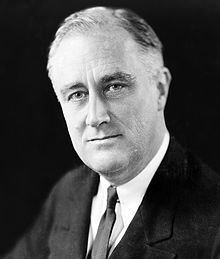
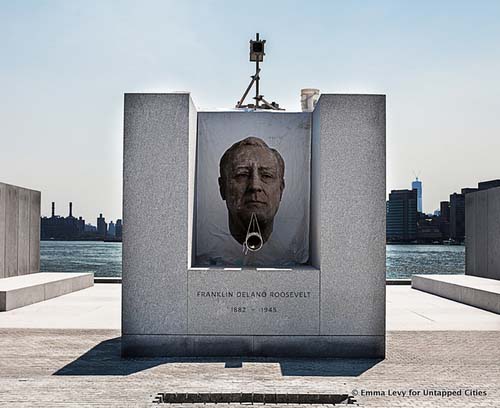 FDR in 1933. |
|